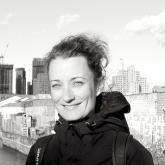The invisible scrubbers at the bottom of the Gowanus
Since 2014, Elizabeth Hénaff, a part of the Sustainable Engineering Initiative at NYU Tandon, has been studying the universe at the bottom of the Gowanus Canal. It’s a notoriously inhospitable place, due in part to the industry that once made the canal a vital commercial shipping hub.
What she, along with a team of six scientists and landscape architects, discovered is a community of extremophiles: a class of microorganisms that can survive extreme conditions, whether that be related to temperature, acidity, or chemical concentration. And these extremophiles, Hénaff and her colleagues found, aren’t simply surviving in the hazardous liquid — rather, they’ve developed a miraculous ability to break down the canal’s noxious substances into its less toxic components.
“It’s poetic in a way,” she said. “It’s like the living microbiome of the canal maintains this record of the history of human intervention at this site. The microorganisms are learning to live in capitalist ruins.”





